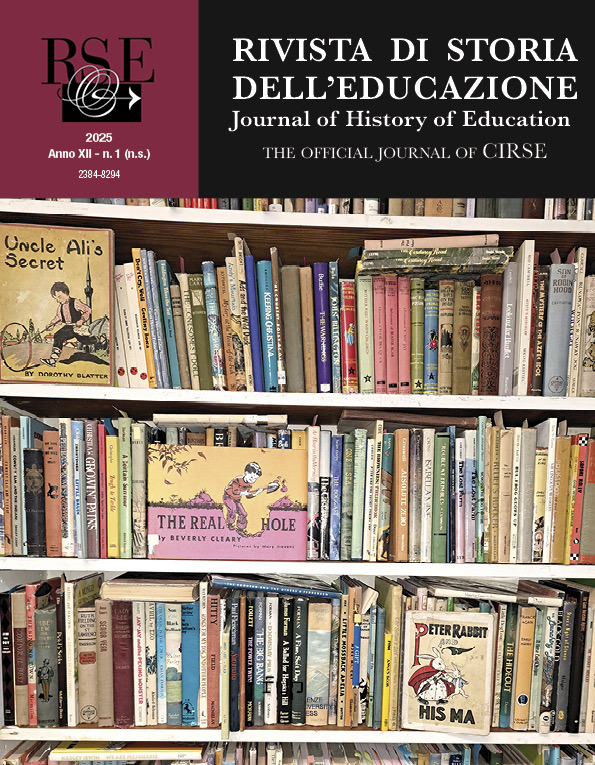Illustrating Gianni Rodari Between 1965 and 1976 in the UK. A Playful Narrative Between Text and Illustration
Published 2025-06-05
Keywords
- Gianni Rodari,
- paratext,
- picturebook,
- children’s literature
How to Cite
Copyright (c) 2025 Claudia Alborghetti

This work is licensed under a Creative Commons Attribution 4.0 International License.
Abstract
Between 1960 and 1980 in the UK, a new vision of childhood stemmed from the aftermath of World War II (Cunningham 1991). Text and illustrations in children’s literature revolved around this vision and welcomed translations although with an eye to protect child readers from texts that could undermine the values accepted in society (Lathey 2010). This research explores the dialogue between translation and illustrations in the works by Gianni Rodari translated for the British public. The methodology follows the paratextual analysis (Genette 1989) in five volumes by Rodari published between 1965 and 1976, in a parabolic trajectory that peaked in 1970 with The Befana’s Toyshop, to fall into oblivion with Tales Told by a Machine (1976). Five books for six illustrators, who insinuate in the folds of the translated text, offering readers further levels of interpretation of the source text (Campagnaro 2019). Through the specific characteristics of each artist (Dick de Wilde, Anne and Janet Grahame Johnstone, A.R. Whitear, Jan Brychta, Fulvio Testa) it is possible to trace an evolution of the aesthetic eye in children’s literature in the UK from a visual experience that intertwines illustrations and text in a balancing act on the page. The aim is to highlight the dissemination strategies that allowed for Rodari’s work to reach the British public in a particularly successful period for children’s literature in the UK, focusing on the dialogue between illustrations and translated text as springboard to stimulate the aesthetic pleasure of young readers.
References
- AA.VV. 1961. Partners in Progress: Some recollections of the past quarter-century at 182 High Holborn. Published privately for the friends of George G. Harrap & Co. Ltd on their Diamond Jubilee. Bristol: Western Printing Services.
- Alborghetti, Claudia. 2023. Gianni Rodari and His English Readers. A Dialogical Perspective. Roma: Armando.
- Andruetto, Marìa Teresa. 2014. Per una letteratura senza aggettivi. Modena: Equilibri.
- Antonello, Pierpaolo. 2019. “Visible Books, Unreadable Books: Bruno Munari’s Iconotextual Playground.” Italian Studies 74 (4): 331-351. DOI: https://doi.org/10.1080/00751634.2019.1658919
- Bader, Barbara. 1976. American Picturebooks from Noah’s Ark to The Beast Within. New York: Macmillan Publishing.
- Boero, Pino. 2020. Una storia, tante storie. Guida all’opera di Gianni Rodari. Trieste: EL.
- Campagnaro, Marnie. 2019. “La pluridimensionalità della visual literacy. Albi illustrati e itinerari educativi.” In Letteratura per l’infanzia. Forme, temi e simboli del contemporaneo, a cura di Lorenzo Cantatore e Susanna Barsotti, 123-144. Roma: Carocci.
- Campagnaro, Marnie. 2024. “The Long Reach of Creativity: The Lasting Impact of 1970s Italian Children’s Literature.” Bookbird 62 (2): 5-13. DOI: https://doi.org/10.1353/bkb.2024.a929805
- Cassin, Alessandro. 2022. “Gli acquerelli di Fulvio Testa in mostra alla Victoria Munroe Fine Art.”: https://lavocedinewyork.com/arts/arte-e-design/2022/10/18/gli-acquerelli-di-fulvio-testa-in-mostra-alla-victoria-munroe-fine-art/ (Ultimo accesso: 26 ottobre 2024)
- Cunningham, Hugh. 1991. The Children of the Poor: Representations of Childhood Since the Seventeenth century. Oxford: Blackwell.
- Daiches, David. 1969. A Critical History of English Literature. Volume II. London: Mandarin.
- Genette, Gérard. 1987. Seuils. Paris: Éditions du Seuil.
- Hunt, Peter, e Lucy Pearson. 2019. “Children’s Books”. In The Cambridge History of the Book in Britain, a cura di Andrew Nash, Claire Squires, e I.R. Willison, 319-340. Cambridge: Cambridge University Press. DOI: https://doi.org/10.1017/9780511862489.010
- Kelleway, Philip, Emma Roodhouse, e Nicola Evans. 2021. The Art of Doris and Anna Zinkeisen. London: Unicorn Publishing Group.
- Lathey, Gillian. 2010. The Role of Translators in Children’s Literature. Invisible Storytellers. London, New York: Routledge. DOI: https://doi.org/10.4324/9780203845233
- Lollo, Renata. 2021. “La letteratura per l’infanzia come relazione triadica.” In La letteratura per l’infanzia a partire dagli studi di Renata Lollo. Linee di ricerca, a cura di Sabrina Fava, 113-126. Rovato BS: Pensa Multimedia.
- Lombello Soffiato, Donatella. 2014. “Le forme della narrativa: spazio educativo e progettualità pedagogica.” In Le terre della fantasia. Leggere la letteratura per l’infanzia e l’adolescenza, a cura di Marnie Campagnaro, 5-38. Roma: Donzelli.
- Nodelman, Perry. 1988. Words about Pictures: The Narrative Art of Children’s Picture Books. Athens: University of Georgia Press. DOI: https://doi.org/10.1353/book26685
- Richardson, Peter. 2013. “Janet and Anne Grahame Johnstone.” Illustrators 5: 64-77.
- Rodari, Gianni. 1965. Telephone Tales. London: Harrap & Co.
- Rodari, Gianni. 1970. The Befana’s Toyshop. A Twelfth Night Tale. London: J.M. Dent & Sons.
- Rodari, Gianni. 1971. A Pie in the Sky. London: J.M. Dent & Sons.
- Rodari, Gianni. 1975. Mr. Cat in Business. London: J.M. Dent & Sons.
- Rodari, Gianni. 1976. Tales Told by a Machine. London: Abelard-Schuman.
- Shulevitz, Uri. 1985. Writing with Pictures. How to Write and Illustrate Children’s Books. New York: Watson-Guptill.
- Terrusi, Marcella. 2012. Albi illustrati. Leggere, guardare, nominare il mondo nei libri per l’infanzia. Roma: Carocci.
- The Kate Greenaway Medal. 2023. “Award Criteria.” https://web.archive.org/web/20120516152201/http://www.carnegiegreenaway.org.uk/greenaway/award_criteria.php (Ultimo accesso: 23 ottobre 2024)
- Thwaite, Ann. 1975. “Verbal limitations.” The Times Literary Supplement, December 5.
- Tucker, Nicholas. 1998. “Ann Grahame Johnstone.” The Independent, June 22.
- Van Coillie, Jan, Wilma van der Pennen, Jos Staal, e Herman Tromp. 1982-2014. Lexicon van de jeugdliteratuur. Groningen: Martinus Nijhoff.


